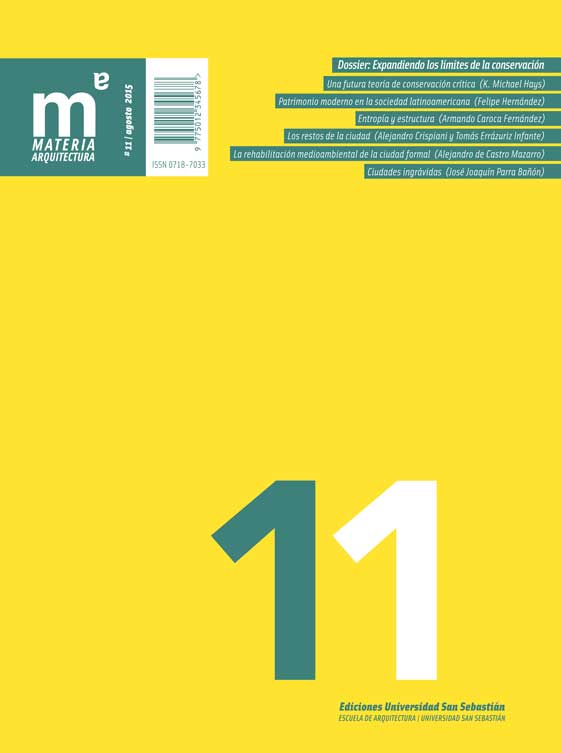Remnants of the city
Article Sidebar
Keywords:
Main Article Content
Abstract
Contrary to what has historically happened with earthquakes that have repeatedly destroyed several cities in Chile, the 2010 earthquake was followed by an unprecedented and fruitful reflection that, from various disciplines, has tried to understand the phenomenon in a new socio-cultural context. Within the framework of this trend, this article explores various uses and representations associated to debris produced by destruction, questioning the traditional approach that conceives them only as useless material whose removal becomes urgent in order to reach the much desired normality. Along these lines, attempts shall be reviewed that try to start a discussion about debris, suggesting new connotations such as possibilities of recycling; evocative force and, therefore, significance as objects of memory and commemoration; or other ways of looking at it linked mainly to art which emphasize the creative and experimental possibilities of what has been destroyed.
Article Details
Materia Arquitectura provides immediate and free access to all the content of this online edition, published simultaneously with the print edition.
Materia Arquitectura does not charge authors for any concept.
All contents of this electronic edition are distributed under the Creative Commons license of "Attribución-shareAlike 4.0 Internacional" (CC-BY-SA).
The rights of the published texts and images belong to their authors, who grant Materia Arquitectura the license for their use. The management of the permits and the authorization of the publication of the images (or of any material) that contains copyright and its consequent rights of reproduction in this publication is the sole responsibility of the authors of the articles.
As long as they mention their origin, the authors are free to distribute their articles by other means. Any total or partial reproduction of the material must mention its origin.
Downloads
References
CISTERNAS, M. (2011). ¿Es Chile central inmune a los terremotos y tsunamis gigantes? (Proyecto Fondecyt n.° 1110848, 2011-2014, Investigador principal). Pontificia Universidad Católica de Valparaíso.
DUCCI, M. E. (2011). Resiliencia y desarrollo local de cara al desastre natural (Proyecto Fondecyt n.° 1110466, 2011-2014, Investigador principal). Pontificia Universidad Católica de Chile.
ELIAS, N. (2011). La soledad de los moribundos. México D. F.: Fondo de Cultura Económica.
FARIÑA, T., OPASO, C., & VERA PUZ, P. (2012). Impactos ambientales del terremoto y tsunami en Chile. Las réplicas ocultas del 27f. Santiago: Fundación Terram.
LYNCH, K. (2005). Echar a perder. Un análisis del deterioro. Barcelona: Gustavo Gili.
REYES MUÑOZ, Y. T. (2012). Violencias urbanas hacia las mujeres post terremoto/tsunami. Los desafíos de la Agrupación de Organizaciones de Mujeres del Maule para la equidad en la Reconstrucción (Tesis para optar al grado de Magíster en Estudios de Género y Cultura, Mención Ciencias Sociales). Universidad de Chile, Facultad de Ciencias Sociales, Santiago.
ROCA, A., & CÁCERES, G. (2014). Concepción monumental: incivilidades, memoriales y subjetividades en conflicto. Red Seca Revista de Actualidad Política, Social y Cultural. Recuperado de: www.redseca.cl/?p=4541
VILLAGRA, P. (2011). Caracterización del paisaje urbano resiliente: percepción del espacio público de Valdivia y Concepción en el contexto de un terremoto (Proyecto Fondecyt n.° 11110297, 2011-2013, Investigador principal). Universidad Austral de Chile.
Most read articles by the same author(s)
- Alejandro Crispiani, Tomás Errázuriz Infante, Los restos de la ciudad , Materia Arquitectura: No. 11 (2015): Materia Arquitectura 11 (Agosto/August 2015)
